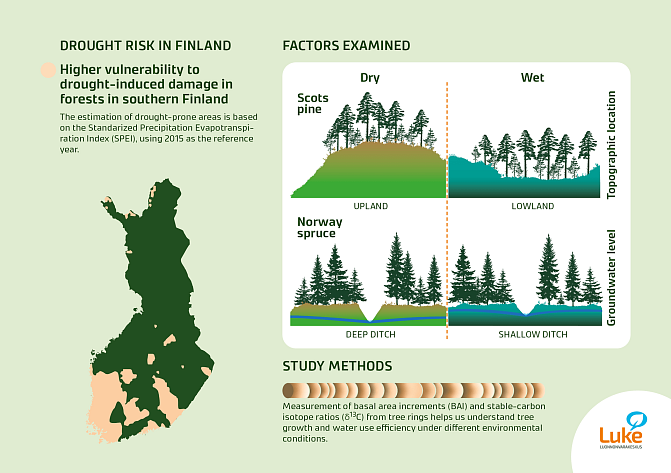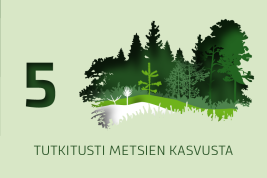Clone of Understanding drought impacts on Finland's forests and forestry
Boreal region is experiencing rapid rate of change in weather conditions due to global warming. These changes include increased frequency and severity of extreme climatic events such as droughts, with southern Finland being particularly vulnerable. Thus, it is essential to understand how tree productivity and health respond to recurrent droughts.
At Luke, our research project studies impact on forest growth. This study here aims to understand better how the feedback between the forest carbon cycle and the climate works in southern Finland's drought-prone areas. This will improve the accuracy of forest growth modeling approaches and helps to define management strategies to enhance the climate change mitigation potential of Finnish forests.

Use of tree-ring measurements as indicators of tree growth response to drought
Every year, trees in boreal forests add a new ring of growth just beneath the tree's bark, thereby providing valuable annual records of growth patterns and environmental conditions. The study of these annual rings, “Dendrochronology”, which is the study of these growth rings, reveals how trees respond to stressors like drought. Narrower rings often indicate tough years, while stable carbon isotope ratios in these rings help us understand a tree’s water-use efficiency - the balance between carbon uptake and potential water loss.
Analyzing these patterns is essential for predicting how future droughts will impact forest health and productivity. This knowledge is critical to developing strategies that help forests respond better to changing climates, especially in drought-prone areas like southern Finland.
The influence of topographical location and groundwater level on the impact of drought
Our research also examines how topography and groundwater levels influence tree growth under drought conditions. We focus on Scots pine forests on dry upland and wet lowland soils and Norway spruce forests in drained peatlands with varying drainage depths.
Upland soils usually have less water, leading to more drought resistance but lower productivity than wetter lowlands. Understanding these differences can guide forest management strategies tailored to varying soil moisture conditions.
By comparing areas with different drainage systems, we learn how water management practices affect tree productivity.
Effective drainage is vital in managing peatland forests, preventing waterlogging that can hinder tree growth. By comparing areas with different drainage systems, we learn how water management practices affect tree productivity.
Preliminary results show a decline in forest growth from 2010 to 2023 compared to 1980 to 2009, and results show that Norway spruce in drained peatlands is experiencing a more significant reduction than Scots pine in mineral soils.
Adaptation of forest management to a warmer and drier future in Finland
The findings from this study are vital for shaping effective forest management and conservation strategies, especially as climate change intensifies in southern Finland. To enhance forest resilience to future droughts, it’s crucial to select drought-resistant tree species and refine forest management practices, such as strategic thinning, to avoid overuse of water resources.
Understanding the variations in tree growth and water-use efficiency across tree species, topographical locations, and drainage conditions is essential for identifying areas that are particularly vulnerable to climatic stresses. Tailoring management strategies to these specific conditions will help ensure that forests remain resilient, continue functioning as carbon sinks, and support biodiversity.
Future research should focus on long-term tree growth and water-use efficiency monitoring to track trends and emerging patterns. Expanding the study to include more tree species and a broader range of ecological conditions across Finland will further inform adaptive management practices.
This article is part of the MEKA2.0-projects work. You can read the previous articles in Finnish, links below.





